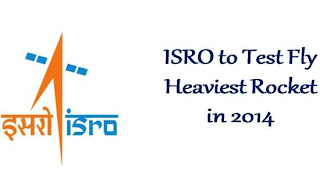 |
| ISRO |
ISRO is planning to launch the heaviest
rocket ever in
2014 on an experimental flight. the later (better too) version of that rocket
might be used to human beings on space missions, which would be quite a
revolutionary achievement in the space research
field for modern India.
The said rocket is likely
to touch the sky in next January of the upcoming year. According to some
relevant sources the Geosynchronous
Satellite Launch Vehicle-Mark III (GSLV-Mk III) might be used to put in
orbit communication satellites that are weighing between four to five tonnes.
This simply means that this vehicle will eventually pack lots of transponders
per launch.
Mr. K Radhakrishnan, the active Chairman of the Indian Space Research Organization (ISRO), recently attended a public
lecture event at the Indian National Science Academy (INSA) in New Delhi. After the event he was talking to the reporters
on various topics.
"We are targeting an
experimental flight of GSLV-Mk III
in January 2014,” Mr. K Radhakrishnan quoted while talking to the press
reporters.
This scientific research project
has some other highlighting features too, as it will be a very first time that
the talented scientists of ISRO would
undertake an experimental flight of a launch vehicle. This has to be mentioned
here that the flight would eventually fall into deep sea after reaching a substantial
height of around 120 km.
The GSLV-Mk III project has
been directed by S Somnath, who is a
very reputed space scientist of India. "We have been simulating the flight
using computers. But there are certain tests that cannot be carried out on the
ground. We will test the rocket in a cost effective manner," the director
said that while talking about his dream project.
He also provided some key
details about the project to give it some sort of light. He said that the engineers
of ISRO are working day and night to make the launch successful. The engineers
have already planned to take around 2,000
necessary measurements the experimental flight of the GSLV-Mk III. It would
weigh 640 tonnes at the time of lift-off, which would surely make it the heaviest rocket ever to be built in Indian soil.
"All
the 2000 measurements during the flight would be telemetered down to the ground
station. We will analyze them. This will enable us to have full knowledge of
the flight," Mr. Somnath explained.
Antrix Corporation, which is the commercial wing of the ISRO, will be
able to provide cheapest space launches
in the market of its category due to the help of this new rocket, as it could
be able to put a four ton satellite in orbit with ease if everything goes well.
Do you like this article and want to stay updated with all the Latest Current Affairs updates? If yes
then please take a second to Subscribe via Email or join our G+ Community. You can send your queries, suggestions to
us by accessing this Contact Us Form, or you can play Current Affairs 2013 Quiz too.

Good to know that Indian Space program will soon have the capacity to handle heavy payloads with the lift-off weight ranging around 640 tonnes. It is obvious that ISRO is attempting to become more self-sufficient which is very much appreciated. I would however like to learn more about launch/mission control facilities that ISRO currently has because often times ISRO relies on international organizations for tracking needs. Here's my simulation-based analysis of Indian Regional Navigation Satellite System:
ReplyDeletehttp://crazymotts.blogspot.in/2013/08/irnss-analysis-of-opportunities-and.html